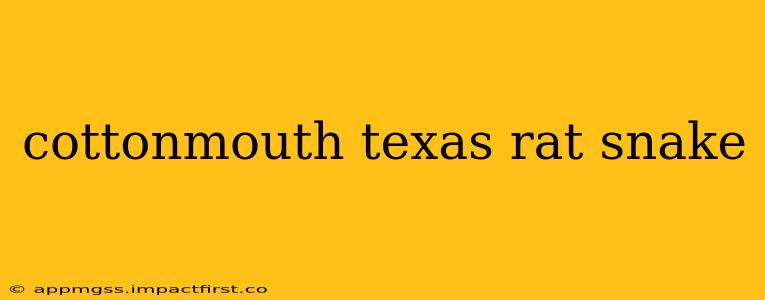The venomous cottonmouth ( Agkistrodon piscivorus) and the non-venomous Texas rat snake (Pantherophis obsoletus) are often confused, leading to unnecessary fear or dangerous encounters. Both species inhabit Texas and share some superficial similarities, making identification crucial for safety. This guide will help you confidently distinguish between these two snakes.
What are the Key Differences Between a Cottonmouth and a Texas Rat Snake?
The most significant difference lies in their venomousness. Cottonmouths are pit vipers, possessing highly potent venom, while Texas rat snakes are harmless constrictors. However, visual clues can also help you tell them apart, although these can be less reliable in younger or unusually colored specimens.
Head Shape
- Cottonmouth: A triangular-shaped head, distinctly broader than its neck, is a key characteristic. This is due to the presence of venom glands.
- Texas Rat Snake: A more elongated, oval-shaped head that gradually tapers into its neck.
Pupil Shape
- Cottonmouth: Vertical, elliptical pupils, resembling a cat's eyes.
- Texas Rat Snake: Round pupils.
Defensive Behavior
- Cottonmouth: Known for its defensive posture, often displaying an open mouth revealing the characteristic white interior of its mouth (hence the name "cottonmouth"). They may also strike defensively. This behavior is not always reliable, however, as a frightened cottonmouth might not display its mouth.
- Texas Rat Snake: While they may hiss and vibrate their tails, Texas rat snakes generally try to flee when confronted. They rarely strike unless severely provoked.
Color and Pattern
Both species exhibit considerable color variation, making this the least reliable identification method. However, some general differences exist:
- Cottonmouth: Typically dark brown, black, or olive, often with darker crossbands or blotches. Younger cottonmouths may have a more striking pattern. The white mouth lining is a defining feature, but only visible when displayed defensively.
- Texas Rat Snake: Coloration ranges from gray and brown to black, often with darker blotches or saddles. Some individuals display a reddish hue. The pattern can be more variable than that of the cottonmouth.
How Can I Identify a Cottonmouth or Texas Rat Snake from a Distance?
Identifying snakes from a distance is inherently challenging, especially given the color variations. Focus on the head shape and general behavior. A triangular head and defensive posture are strong indicators of a cottonmouth. If the snake is exhibiting a defensive posture, it's best to back away slowly and give it space. Never attempt to handle a snake you are unsure of.
What Should I Do If I Encounter a Cottonmouth or Texas Rat Snake?
- Give it space: Maintain a safe distance and allow the snake to move away undisturbed.
- Avoid provoking it: Do not try to handle or kill the snake.
- Alert others: If you encounter a snake near a frequently used area, inform others and relevant authorities.
- Seek medical attention: If bitten by a snake, seek immediate medical attention.
What is the best way to prevent snake encounters?
- Keep your yard clean: Remove brush, debris, and overgrown vegetation that provide shelter for snakes.
- Secure your property: Seal gaps and cracks in your house, shed, and fences to prevent snakes from entering.
- Be aware of your surroundings: Watch where you step and reach.
- Wear appropriate clothing: Avoid walking through tall grass or brush without protective footwear.
Remember, the safest approach is to avoid handling any wild snake. If you are unsure about a snake's identity, always err on the side of caution and leave it alone. Consulting with a local herpetologist or wildlife expert can also provide further assistance in identification. This information is for educational purposes and does not replace professional advice.
